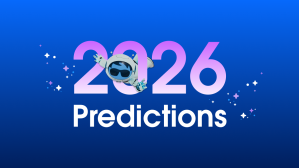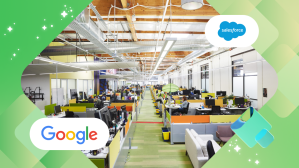2025 delivered enterprise AI that moved beyond simple prompts and reactive text generation into a new reality where digital agents don’t just talk — they act.
The emergence of “vibe coding,” the fast-growing trend of using generative AI to spin up code from plain-language prompts — quickly democratized development but introduced security and reliability concerns. Simultaneously, businesses had to confront the reality of “workslop” — the tide of low-quality, hallucinated AI noise that forced employees to spend hours auditing the very agents meant to save them time.
Moving into 2026, agentic momentum is undeniable. A new Salesforce study of CIOs finds AI adoption has skyrocketed 282%, a sign of the technology’s pull. Yet the report also reveals that a significant number of leaders remain hesitant to make the full leap to an autonomous agent-first strategy. The reason? Trust in data has become the number one bottleneck, as leaders weigh the risks of autonomous action against the undeniable rewards of scale.
The question now is not whether agents will change how work gets done but how organizations will orchestrate, trust, and live alongside them. The following predictions explore:
- The future of agentic AI: Proactive, multi-agent systems
- Trusted agentic AI as a differentiator
- Unexpected use cases of agentic AI
- Agentic AI’s broader impacts
- What it will take to make agentic AI successful
What is Salesforce (and why are its executives predicting the future)?
Salesforce helps organizations of any size become Agentic Enterprises – integrating humans, AI agents, apps, and data on a trusted, unified platform to unlock unprecedented growth and innovation.
Salesforce leaders are on the front lines of the latest AI trends, technologies, and challenges impacting businesses and are helping customers in every industry with their Agentic Enterprise transformation journey. They bring expertise and insight from market analysis, customer conversations, and internal data to help reveal what tomorrow may bring.
The Future of Agentic AI: Proactive, Multi-Agent Systems
The future of AI isn’t a robot; it’s a team. “Companies will rapidly transition to an ‘orchestrated workforce’ model. We are shifting from monolithic AI to a system where a primary ‘orchestrator’ agent directs smaller, expert agents. This model allows for greater specialization, efficiency, and scalability, much like a well-managed human team. Crucially, this model ensures humans remain in control, shifting the human role to a high-level supervisor who leverages AI-powered observability tools to set guardrails, ensure ethics, and oversee the entire digital team’s performance.” — Armita Peymandoust, SVP, Forward Deployed Engineering, Salesforce
The multi-Agentic Enterprise will finally arrive. “In 2026, single AI agents will become digital dead-end islands, offering isolated value but failing to scale, trapping enterprises in a productivity paradox. True enterprise success will demand a fully orchestrated digital workforce where agents collaborate seamlessly with other agents, across departments, and outside the organization. This transition from single agents to multi-agent intelligence is blocked by a failure to establish three necessary technology foundations: multi-agent protocol for open interoperability and communication, integrated multi-agent context for a unified data foundation, and robust multi-agent governance for security and observability of all agents.” — Muralidhar Krishnaprasad (MK), President & CTO, C360 Platform, Apps, Industries & Agentforce
Agents will move from task takers to outcome owners. “We’re going to go from task-taking conversational assistant agents to outcome-owning agents that are deeply embedded into the fabric of work. Instead of giving agents instructions, we’ll give agents goals. Whether it’s improving customer satisfaction, growing pipeline, or reducing time to resolution, agents will dynamically learn to orchestrate people, processes, and data to drive results for you by operating proactively within your business with deep organizational awareness. Think of it as the shift from ‘here’s what to do’ to ‘here’s the outcome I want.’ The next transformation will happen when AI agents don’t just follow instructions, they advance outcomes.” — Nancy Xu, VP, Salesforce AI
Agents will go from user-initiated to event-driven. “Agents will gain autonomy and initiate work based on events. For instance, one agent discovering a performance issue will automatically communicate with a development agent, instructing it to analyze, fix the problem, and perform testing without human prompting.” — Dan Fernandez, VP, Product, Developer Services
Simulation “gyms” will supercharge enterprise learning loops. “By 2026, agents will learn faster than the real world allows by combining shared meaning standards with simulation ‘gyms’ where they can practice, fail, and improve on repeat. When data keeps its context across platforms and agents train in accelerated environments, learning loops take off and enterprises get safer, smarter agents at scale. Salesforce’s eVerse is an early example of how this works, and it’s already delivering improved outcomes for customers. Over time (likely post-2026), new interfaces will unlock the power of simulations for knowledge workers, giving them the ability to conduct rich, what-if analysis before recommending or taking action.” — Marc Escobosa, VP, Salesforce Futures
New interfaces will unlock the power of simulations for knowledge workers, giving them the ability to conduct rich, what-if analysis before recommending or taking action.
Marc Escobosa, VP, Salesforce Futures
Trusted Agentic AI as a Differentiator
A brand’s identity will be defined by its AI’s identity. “By 2026, brands won’t be defined by logos or slogans; they will be defined by their AI. These customizable agents will become the ultimate brand ambassadors: smart, personalized, and continuously evolving with every exchange. In this new reality, the divide will be absolute, and the brands that win will be the ones whose AI delivers a consistently exceptional experience, and everyone else will fall behind.” — Adam Evans, EVP & GM, Salesforce AI
Relational intelligence as a differentiator in agentic experiences.“With popular consumer chatbots getting more agentic by the day, users are already growing accustomed to digital interactions informed by history, preferences, and personalized context. In contrast, generic experiences are starting to feel more and more broken. As deep personalization becomes the norm, companies will increasingly need to focus on relational intelligence as a key differentiator. We’ll see resources shift from competing for attention to investment in deeper, more nuanced, more long-term relationship-building. The companies who figure out how to port relationship-building to the agentic realm will have an enormous first-mover advantage as AI commerce accelerates. 2026 sees the rise of ‘chief relationship officers’ who own customer relationships across departments and functions.” — Mick Costigan, VP, Salesforce Futures
AI’s interface will be the new competitive edge. “By 2026, every company will have an AI interface, but in an increasingly crowded market, true differentiation will come from AI that delivers real business outcomes. The agentic transformation of the customer experience will be the most important investment companies make, as we move from a year of experimentation to a year of measurable impact. CEOs will lead this shift, focusing their organizations on a select set of trusted partners who can help them turn AI potential into results that are grounded in customer centricity; intelligent workflows; and an open, enterprise-grade platform built to fit their business.” — Madhav Thattai, COO, Salesforce AI
Trusted agentic AI adoption will become a key driver for shareholder value. “In 2026, we’ll see shareholders take a more vested stake in how companies are using AI agents to work smarter while still ensuring trustworthy outcomes. We’ll move past the experimental phase to highlighting exactly how AI agents drive real business value. Companies that openly explain how their AI tools work and share their success stories will find themselves in a strong position to build lasting confidence and trust with all stakeholders.” — Sabastian Niles, President & Chief Legal Officer
Instruction adherence will become a key reliability metric. “In 2026, the question of whether an agent is ‘working’ will shift from simple output to measurable instruction adherence, becoming the industry’s new key reliability metric for AI governance. Enterprises will demand probabilistic adherence scores — categorized as high, low, or uncertain — to enable developers to refine their instructions accordingly and gain the confidence of CIOs in their agents’ reliability and trustworthiness. This focus on a quantitative measure of compliance will be essential for scaling enterprise agents and avoiding costly errors, setting a new benchmark for safe and reliable AI.” — Mohith Shrivastava, Principal Developer Advocate
Connected intelligence will be the next competitive advantage. “The companies that win won’t be the ones deploying the most AI — they’ll be the ones rewiring their operating model around connected intelligence. This is where the first true agentic enterprises take shape: humans and AI teammates working in the same context, in real time, with execution finally moving at the speed of intent. Work shifts from passive stand alone productivity to prioritized and purposeful work In this world, advantage belongs to the companies that treat Slack not as a collaboration tool, but as the operating system for their enterprise intelligence — the place where knowledge lives, decisions are made, and action happens.” — Denise Dresser, CEO, Slack
Unexpected Use Cases of Agentic AI
AI will move to proactive cyber hunting. “AI continues to change the game for cybersecurity for both defenders and bad actors. Just as cybersecurity teams are leveraging AI to enhance efficiency and bolster defenses, bad actors are using it to scale attacks. Think of AI like what e-bikes have done for cycling — the rider still needs to balance and turn the pedals, but it gives them a boost in speed, range, and endurance. AI will increase the pace and range of both attackers and defenders, but many of the tasks will remain familiar. AI helps teams cover more ground: automating repetitive tasks, detecting anomalies, predicting attacker behavior, and processing massive datasets to surface risks in real time. By integrating AI into threat intelligence and response, organizations can move from reacting to anticipating and responding to threats faster than ever.” — Brad Arkin, Chief Trust Officer
By integrating AI into threat intelligence and response, organizations can move from reacting to anticipating and responding to threats faster than ever.
Brad Arkin, Chief Trust Officer
AI models imbued with spatial intelligence will unleash a new race toward autonomy. “Although LLMs based on the Transformer architecture unleashed the modern AI race, they still lack a grounded understanding of how the physical world works. Emerging world model architectures, like those being developed by Fei-Fei Li’s World Labs, expand intelligence by training on neural radiance fields, point clouds, and richer 3D data. These models promise a more coherent grasp of space, geometry, and even basic physical forces like gravity and pressure. As these emerging capabilities mature, they’ll accelerate robotics, enable the development of immersive simulations and more intelligent real-world automation. In 2026, the race to develop these models and apply them to practical use cases will accelerate.” — Daniel Lim, Senior Director, Salesforce Futures
Forget firewalls: Agentic AI will be the “self-healing” corporate immune system. “When it comes to security, agentic AI won’t be just a tool but rather a system that acts like a biological immune system. By late 2026, the industry will shift focus from perimeter defense to autonomous workflow integrity, using agentic AI to monitor the ‘health’ of business processes rather than just network endpoints. These autonomous security agents will establish a continuous behavioral baseline for critical systems and, upon detecting a threat deviation, will autonomously isolate the infected workflow and apply patches in milliseconds, achieving a state of ‘self-healing’ security. This will eliminate a large percentage of low- to mid-level security alerts, allowing human teams to exclusively focus on strategic threat hunting and governing the AI agents’ autonomous actions. The biggest operational challenge will become trusting an AI to initiate a system change before seeking human approval.” — Marla Hay, SVP, Product, Security, Privacy & Data Protection
Agentic AI’s Broader Impacts
AI-native engineers will reshape engineering culture, not just code. “The rise of the ‘AI-native engineer’ is set to fundamentally redefine software development, moving beyond individual efficiency to collective organizational intelligence. The next wave will be measured by how fast teams convert ideas into shipped outcomes collectively. This new generation of AI-native engineers now quickly synthesize multiple design documents, grasp coding practices, and familiarize themselves with complex codebases within hours, rather than the weeks or months previously needed. As a result, we’ll see a new dynamic among engineering teams with a mutual value exchange. Experienced developers share system architecture knowledge and domain expertise while receiving cutting-edge technique training from their AI-native junior teammates. These evolving mentorship dynamics foster an ideal environment for organic innovation sharing. Organizations that formalize this pairing will ship features 30%–50% faster and unlock millions in innovation velocity.” — Vivienne Wei, COO, Unified Agentforce Platform
Democratization will spawn a new category of personal apps. “As development barriers continue to lower through platforms that provide pre-configured, browser-based IDEs and high-level abstractions, a new category of internal applications will emerge. These personal apps will be built by non-traditional developers — people who previously might have used Excel spreadsheets — to solve individual problems, run experiments, or visualize data within the company context. This democratization will make it possible for anyone to quickly ‘vibe code’ an application that is tailored to their specific needs, using the enterprise’s existing infrastructure and context.” — Dan Fernandez, VP, Product, Developer Services
Ambient intelligence gets closer to reality. “Predictions of new interface patterns are notoriously difficult. Even a technology that is ‘indistinguishable from magic,’ like VR, still has to meet human needs to scale. Real-world usage has a way of revealing flaws that anticipatory enthusiasm tends to overlook. But new, more ambient, AI-first interaction patterns are starting to remove friction, provide shorter routes to usable intelligence, and enable users to delegate tasks without diving in with taps and clicks. Imagine an always-on agentic teammate who listens in on work conversations (with permission, of course) and executes in real time to help teams work smarter and faster. Better voice capabilities, personalized UI, more intuitive autocomplete designs, and faster learning loops will all help drive agentic ambience. In combination, these breakthroughs will erode some of the reliance on the phone and desktop that dominate so much of today’s interaction with AI — especially for consumer use cases like product research, shopping, and trip and event planning. In 2026, we may even see an ‘AI device’ break through in a meaningful way.” — Peter Schwartz, SVP, Strategic Planning
Sustainable AI will have an unlikely hero: water. “As Agentic Enterprises become the norm, AI’s environmental footprint is coming into sharper focus in the boardroom — and water is emerging as the unexpected battleground for sustainable innovation. Next year, we’ll see companies realize that addressing AI’s water consumption isn’t just about conservation; it’s fundamentally rethinking how and where we power intelligence. The most strategic leaders will understand that optimizing AI compute results not only in cost savings but also in sustainability and performance benefits such as reduced emissions, less water consumption, and improved latency.” – Sunya Norman, SVP, Impact
The most strategic leaders will understand that optimizing AI compute results not only in cost savings but also in sustainability and performance benefits such as reduced emissions, less water consumption, and improved latency.
Sunya Norman, SVP, Impact
Washington will go bullish on AI upskilling — fast. In 2026, the federal government will move to dismantle barriers that have long stifled AI skill development among federal employees. With digital agents increasingly transforming public services, the White House and Congress will approach AI fluency not as a tech initiative but as a matter of national competitiveness and workforce readiness. The narrative will flip: AI won’t replace public servants; it will rescue them from outdated systems. Momentum is building for legislation and funding that build a blended federal workforce, where human judgment and AI capability operate side by side — modernizing government operations and redefining what it means to serve in public office in the AI era.” — Hugh Gamble, VP, Federal Government Affairs & Policy
Agents will shift more power to consumers and elevate marketplace competition. “Better consumer agents give their human proxies far more power to optimize spend, comparison shop at far greater scale, research like a pro, and negotiate like a battle-tested trial attorney. Consumers are already delegating some complaints and communication with companies to their AIs, feeding contracts through their chatbot of choice, and consulting before buying additional add-on services. These behaviors in total mean that consumers are already savvier, more discerning, more informed, and more likely to take their dollars elsewhere if a company doesn’t meet their expectations. While some companies — especially those who prey on information gaps and attention-jacking — might worry about revenue hits, quality companies who focus on evergreen attributes like value and customer service will benefit from less noise in the market. These winning organizations will see their TAMs begin to expand as bad actors are weeded out, opaque and underdeveloped markets are flooded with sunlight, and selling opportunities go exponential.” — David Berthy, Senior Director, Salesforce Futures
What It Will Take to Make Agentic AI Successful
Agentic AI adoption will hinge on AI literacy and confidence. “In 2026, the conversation around agentic AI will shift to the human element — specifically, AI literacy and employee confidence. While the technology moves fast, what’s imperative is empowering people to be confident with AI — knowing how to spot inaccuracies, how to tune outputs, and when to intervene. The priority for the coming year is mastery. We need to break down technical barriers and enable every employee to become a capable pilot of AI agents.” – Paula Goldman, Chief Ethical & Humane Use Officer
The “build vs. buy” debate will end, and the platform integration era will begin. “Over the past year, a clear pattern has emerged: generative AI helps you create, while agentic AI helps you operate. But pilots only scale when the underlying systems are connected, governed and adaptable. As CIOs deepen their understanding of the difference between generative and agentic architectures, the old “build vs. buy” debate will give way to a more strategic question in 2026: Which platforms offer native agentic integration across the rest of my tech stack? CIOs will consider platforms that come pre-connected, pre-governed and purpose-built for multi-agent orchestration — because adaptability at scale depends on interoperability, not isolated excellence — this being the decisive advantage.” — Shibani Ahuja, SVP of Enterprise IT Strategy
Employee engagement will determine AI success. “Leading agentic enterprises will understand that AI is a people transformation just as much as it is a technological one. Success won’t come from rolling out new tools alone. It will come from employees who feel connected to purpose, confident that their voices are heard, and supported to take smart risks. When people feel highly engaged and trusted to innovate, they can experiment courageously and drive higher impact for every community. Organizations that embrace this truth will unlock a culture of curiosity, collaboration, and continuous learning — thereby accelerating value creation and proving that our most powerful competitive advantage is an engaged and empowered workforce.” — Alexandra Siegel, Chief Equality & Engagement Officer
Forward Deployed Engineers (FDEs) will help shape the next generation of agentic products. “The companies winning in the agentic era will be embedding FDEs into their product discovery and deployment loops. Just as Salesforce’s FDEs work alongside customers to turn proof of concept into production systems that actually work, we’ll see FDEs across the industry help slash time to value, feed next-gen features, refine model behavior, and embed enterprise logic into agentic systems.” — Mark Wakelin, EVP, Forward Deployed Engineering
Regulation will unlock the AI agent economy. “Looking ahead to 2026, regulation — not technology — will be the biggest accelerant for AI agent adoption. Laws will turn AI governance from a vague ambition into a defined operational discipline. For most enterprises, that clarity is liberating. The biggest barrier hasn’t been innovation — it’s been fear: liability, bias, misuse, brand damage. Once ‘acceptable risk’ is codified through transparency, oversight, and agent risk tiers, organizations will move from pilots to production. Risk-based regulation won’t slow AI down. It will professionalize it — and give enterprises the confidence to deploy agents at scale.” – Lindsey Finch, EVP, Global Privacy, Product, AI & Cybersecurity Legal
Governments and industry will step up collaboration on AI guardrails. “In 2026, governments and private companies will deepen their partnerships to govern AI effectively. The technology moves too fast and the AI ecosystems are growing too complex for governments to establish and enforce guardrails alone. It’s easy to assume that trust comes from more government rules — but the reality is different. Trust will come from co-created standards, where government, industry, and public stakeholders set the rules, hold each other accountable, and ensure AI is developed ethically and responsibly. Collaboration is no longer just an option — it will be the only way to keep AI safe, fair, and trustworthy while also protecting innovation.” — Aliki Foinikopoulou, Senior Director, Global Public Policy
We’ll see a boom in deeply vertical, domain-specific products built by the people who know their niches best. “The integration of SaaS, data, and AI will turn everyday problem solvers — from farmers to dental practices — into software entrepreneurs and help them optimize, productize, and sell their own solutions for others like them. This type of innovation once belonged to those with deeper pockets or large-scale practices employing many engineers. In 2026, we’ll see enterprise platforms and AI-assisted coding tools enable startup speed for any segment, sparking a new depth of software and new generation of builders who transform their verticals by operationalizing AI.” — Brian Landsman, CEO of AppExchange and EVP of Global Partnerships
Read more
- Hear from Salesforce’s Head of Engineering on why 95% of AI pilots fail and what the other 5% do differently
- Read how agents will make the org chart obsolete.




















